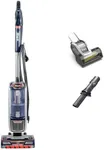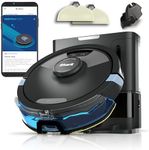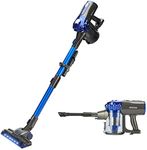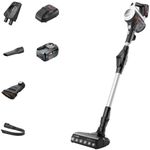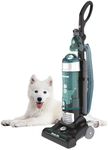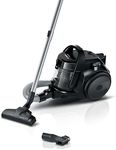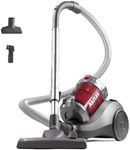Buying Guide for the Best Bagless Vacuums
Choosing the right bagless vacuum cleaner can make a significant difference in maintaining a clean and healthy home. Bagless vacuums are popular because they eliminate the need for replacement bags, making them more convenient and cost-effective in the long run. When selecting a bagless vacuum, it's important to consider several key specifications to ensure you get the best fit for your needs. Here are the key specs to look out for and how to navigate them.Suction PowerSuction power is a measure of how effectively a vacuum can pick up dirt and debris. This is important because stronger suction means better cleaning performance, especially on carpets and rugs. Suction power is often measured in watts or air watts. Higher values indicate stronger suction. For homes with thick carpets or pets, a vacuum with higher suction power is recommended. For homes with mostly hard floors, moderate suction power may suffice.
Filtration SystemThe filtration system in a vacuum cleaner determines how well it can trap dust, allergens, and other particles. This is crucial for maintaining indoor air quality, especially for allergy sufferers. HEPA (High-Efficiency Particulate Air) filters are the gold standard, capturing 99.97% of particles as small as 0.3 microns. If you have allergies or asthma, look for a vacuum with a HEPA filter. For general use, a vacuum with a good multi-stage filtration system should be adequate.
Dustbin CapacityDustbin capacity refers to the amount of dirt and debris the vacuum can hold before needing to be emptied. This is important for convenience and efficiency, as a larger capacity means fewer trips to the trash can. Dustbin capacities can range from small (less than 1 liter) to large (over 2 liters). For larger homes or those with pets, a vacuum with a larger dustbin is ideal. For smaller spaces or less frequent cleaning, a smaller dustbin may be sufficient.
Weight and ManeuverabilityThe weight and maneuverability of a vacuum cleaner affect how easy it is to use, especially if you have multiple floors or need to carry it up and down stairs. Lighter vacuums are easier to handle and maneuver around furniture. If you have a large home or physical limitations, look for a lightweight model with swivel steering for better maneuverability. For smaller homes or single-floor living, weight may be less of a concern.
Noise LevelNoise level is an important consideration if you are sensitive to loud sounds or have young children or pets. Vacuum noise levels are measured in decibels (dB). Quieter vacuums typically operate at around 60-65 dB, while louder models can exceed 70 dB. If noise is a concern, look for vacuums specifically designed to operate quietly. For general use, the noise level may be less critical.
Attachments and AccessoriesAttachments and accessories enhance the versatility of a vacuum cleaner, allowing you to clean different surfaces and hard-to-reach areas. Common attachments include crevice tools, dusting brushes, and upholstery tools. Consider what types of surfaces and areas you need to clean. If you have pets, look for a vacuum with a pet hair attachment. For homes with a variety of surfaces, a vacuum with multiple attachments will be more versatile.
Corded vs. CordlessCorded vacuums offer consistent power and are ideal for larger cleaning tasks, while cordless vacuums provide greater mobility and convenience, especially for quick clean-ups. Cordless vacuums are powered by rechargeable batteries, so consider the battery life and charging time. If you need to clean large areas or prefer uninterrupted power, a corded vacuum is a better choice. For smaller spaces or quick, on-the-go cleaning, a cordless vacuum may be more suitable.

